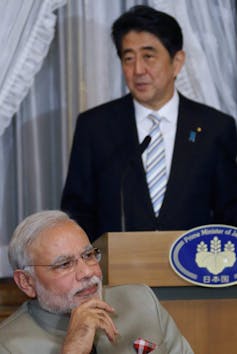During his first year in office, Prime Minister Tony Abbott has conducted a surprisingly energetic and focused foreign policy. Economic diplomacy is one of its principal tools with business delegations and trade agreements playing a prominent role, while the New Colombo Plan emphasises the importance of people-to-people links in advancing Australian interests. But the most important concern for the Abbott government’s foreign policy team is relations with Asia’s major powers.
The goal is to develop first-rate relationships with all five of the region’s major powers, the United States, China, Japan, India and Indonesia. Abbott’s return on Sunday from successful state visits to India and Malaysia means that the PM has been to the capitals of all these countries in his first year. More importantly, in each case the government has made important diplomatic headway.
Of the major relationships on which Abbott is focused, India is perhaps the most challenging. Australian governments of both stripes have sought to improve relations with India, yet realising the potential remains difficult.
India-Australia trade has grown recently but remains one-tenth of the value of Australia-China trade. And diplomatic relations have been challenged by many issues. Perhaps the most important of these has been Australia’s response to India’s 1998 nuclear tests.
Nuclear deal seals rapprochement
On Friday, the two prime ministers inked the final agreement that will allow the sale of Australian uranium to India. Australia’s position on India’s nuclear program had long been an irritant to the relationship. While the market opportunities for export are real, it is not a major dollar value program; its importance lies much more in being a means to improve the strategic relationship.
In the past, Australia had felt that the value of the nuclear non-proliferation regime was more important than good relations with New Delhi. The mood has changed. Australia believes that its relationship with India is sufficiently important to relax its once-firm stance on proliferation.
Canberra’s thinking is also informed by the view that the NPT regime is no longer particularly effective. This was especially so once the US concluded its civilian nuclear agreement with India in 2008. Finally, the government thinks India’s safeguards arrangements are sound and that the prospects of Australia’s actions influencing the dynamics of further proliferation are slight.
Next stop, a free trade agreement
While in India, Abbott was joined by Trade Minister Andrew Robb and the government publicly targeted the conclusion of a free trade agreement (FTA) with India by 2016. Australia is keen to increase bilateral trade and an FTA would certainly help.
Such an agreement is unlikely in such a short time frame. However, it continues Australia’s commitment to economic diplomacy. The Abbott government sees trade agreements as important signals of strategic policy.
The other key component of the visit was education. A signature initiative of the Abbott government is its New Colombo Plan. This provides substantial new funding to send Australian university students to Asia as part of their undergraduate studies. India is an important part of the program and both governments want more Australians to spend time in India.
Beyond the specifics of the bilateral visit, the meeting had an added salience due to the sense of geopolitical change evident in the region. China’s rise has prompted considerable uncertainty. In response, key regional players are repositioning themselves in anticipation of a changing regional context.

Prime Minister Narendra Modi has only recently taken office and he has made plain his desire for India to increase its influence in the region and the world. The day before meeting Abbott, Modi returned from a five-day visit to Japan during which he established an excellent rapport with Prime Minister Shinzo Abe. Japan itself has been extraordinarily active in regional diplomacy and developing a more expansive security relationship with Australia has been a key part of that effort.
Australia wants better relations with India because of shared interests in things like Indian Ocean security and improved trade and investment opportunities, but it is also prompted by a changing strategic context. Australia believes that China’s rise potentially destabilises the regional status quo. The US is the predominant power and Australia wants the international rules of the road, and its geopolitical map, to remain as they are.
Building an alliance of Asian democracies
Canberra thinks that the best way to buttress the existing arrangements in the face of China’s rise is for Asia’s democracies - Japan, India, Australia and others - to do more individually and collectively in support of the status quo. The mission to New Delhi was as much about this broader ambition as it was about improving trade, tourism and educational exchange.
Much is riding on the India relationship. A considerable amount has been achieved and there is plenty of cause for optimism, particularly given the bipartisan stance in Canberra on this. Yet past experiences with Australian-India relations show us there is no room to be complacent.
Improving trade will be difficult for so long as doing business in India remains hard. While Modi has made economic reform his top priority, it will be a long while before economic relations take off.
Improving people-to-people links remains equally challenging. The New Colombo Plan is a great initiative, but convincing Australian students to spend time in India remains very difficult. The appeal of Milan or Manchester over Mumbai and Mysore is powerful in the minds of Australian undergraduates.
Finally, while the two nations have some common interests, particularly in the Indian Ocean, it is not entirely clear that Australia and India have quite the same view of the importance and role of the US in Asia.
Australia has much work to do to realise the ambition it has for its relationship with India. The next opportunity to further this will occur in November when Modi visits Australia to attend the G20 summit.

